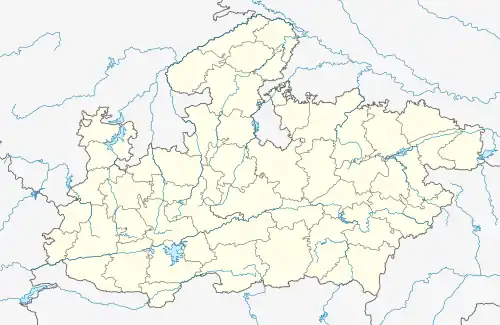| Siddhachal Caves | |
|---|---|
 Colossal Jain statues in Gwalior | |
| Religion | |
| Affiliation | Jainism |
| District | Gwalior |
| Deity | Tirthankaras |
| Location | |
| Location | Gwalior Fort |
| State | Madhya Pradesh |
| Country | India |
 Shown within India  Siddhachal Caves (Madhya Pradesh) | |
| Geographic coordinates | 26°13′26.3″N 78°09′54.6″E / 26.223972°N 78.165167°E |
| Architecture | |
| Style | Jainism |
| Creator | Tomaras of Gwalior |
| Date established | 7th-century |
| Completed | 15th-century |
Siddhachal Caves are Jain cave monuments and statues carved into the rock face inside the Urvashi valley of the Gwalior Fort in northern Madhya Pradesh, India. There are the most visited among the five groups of Jain rock carvings on the Gwalior Fort hill. They were built over time starting in the 7th-century, but most are dated to the 15th-century CE. Many of the statues were defaced and destroyed under the orders of the Muslim Emperor Babur of the Mughal dynasty in the 16th century, while a few repaired and restored after the fall of the Mughal dynasty and through the late 19th century.[1]
The statues depict all 24 Tirthankaras. They are shown in both seated Padmasana posture as well as standing Kayotsarga posture, in the typical naked form of Jain iconography. The reliefs behind some of them narrate scenes from the Jain legends. The site is about 2 kilometres (1.2 mi) from the South-East Group of Gopachal rock cut Jain monuments and about 1 kilometre (0.62 mi) northwest of the Teli ka Mandir within the Gwalior Fort.[2]
The Siddhachal Jain collosi cave temple is one of the Archaeological Survey of India's Adarsh Smarak Monument along with other monuments in the Gwalior Fort.[3]
Location


The Siddhachal collosi cave temples are located inside fortifications of the Urvahi valley, a part of the fort of Gwalior, Madhya Pradesh, immediately below the northwestern walls of the fortress. The Gwalior city and the fort is connected to other Indian cities by major highways NH 44 and 46 (Asian Highway 43 and 47), a railway station and airport (IATA: GWL). It is located near other historic Hindu and Jain temples from the medieval era.[2][4][5]
History

The Siddhachal cave temples are a part of nearly 100 Jain monuments found in and around the Gwalior city, all dated to be from the 7th to 15th century. The Siddachal colossi are near the Urwahi road, and most are dated to be from the 15th century, built in an era when Delhi Sultanate had collapsed and fragmented, a Hindu kingdom was back in power in Gwalior region and before Babur had ended the Delhi Sultanate and replaced it with his Mughal dynasty. The inscriptions found near the monuments credit them to the Tomar kings, and they range from the 1440 to 1453 CE. The Siddhachal Caves were complete by about 1473 CE. Some 60 years after they had been completed, the statues were defaced and desecrated around 1527 when the Emperor Babur ordered their destruction.[1][6][7] Babur explained in a memoir,
They have hewn the solid rock of the Adwa [Urwa], and sculptured out of it idols of larger and smaller size. On the south part of it is a large idol, which may be about 20 gaz (40 feet in height). These figures are perfectly naked, without even a rag to cover the parts of generation. Adwa is far from being a mean place, on the contrary it is extremely pleasant. The greatest fault consists in the idol figures all about it: I directed these idols to be destroyed.[1]
The Jain cave temples within the Gwalior Fort were, however, not destroyed, just mutilated by chopping off the faces, the sexual organs and their limbs. Centuries later, the Jain community restored many of the statues by adding back stucco heads on the top of the damaged idols.[1]
Description
The Siddhachal Caves are rock-cut monuments with Jain collosi. They are found on both sides of the slope of the Urwahi road in the fort, along the Urwahi valley. The monuments include many caves, small reliefs on the walls, as well as 22 colossi. The largest of these are for Rishabhanatha (Adinatha), identifiable by the bull emblem carved on the pedestal under his foot, with a height of 57 feet (17 m). Other colossi include a seated 30 feet (9.1 m) Neminatha (shell icon on his pedestal), Parshvanatha with serpent cover over his head and Mahavira (lion icon on his pedestal).[8][2][1][9]
Gallery
 View of the caves below the fort in 1885
View of the caves below the fort in 1885 Jain Temple Fort Gwalior
Jain Temple Fort Gwalior Jain Goddess
Jain Goddess Panel with Arihant
Panel with Arihant
See also
References
Citation
- 1 2 3 4 5 Gwalior Fort: Rock Sculptures, A Cunningham, Archaeological Survey of India, pages 364-370
- 1 2 3 Kurt Titze; Klaus Bruhn (1998). Jainism: A Pictorial Guide to the Religion of Non-violence. Motilal Banarsidass. pp. 106–110. ISBN 978-81-208-1534-6.
- ↑ "Adarsh Smarak Monument". Archaeological Survey of India. Retrieved 19 July 2021.
- ↑ Group of temples at Batesar, ASI Bhopal Circle (2014)
- ↑ Naresar Temples, ASI Bhopal Circle (2014)
- ↑ Kurt Titze; Klaus Bruhn (1998). Jainism: A Pictorial Guide to the Religion of Non-violence. Motilal Banarsidass. pp. 101–102. ISBN 978-81-208-1534-6., Quote: "In 1527, the Urvahi Jinas were mutilated by the Mughal emperor Babar, a fact he records in his memoirs".
- ↑ Trudy Ring; Noelle Watson; Paul Schellinger (2012). Asia and Oceania: International Dictionary of Historic Places. Routledge. p. 314. ISBN 978-1-136-63979-1.
- ↑ Burgess 1880, p. 509.
- ↑ Gwalior Fort, Archaeological Survey of India, Bhopal Circle, India (2014)
Sources
- Burgess, James (1880). The Cave Temples of India (1st ed.). W. H. Allen & Co.